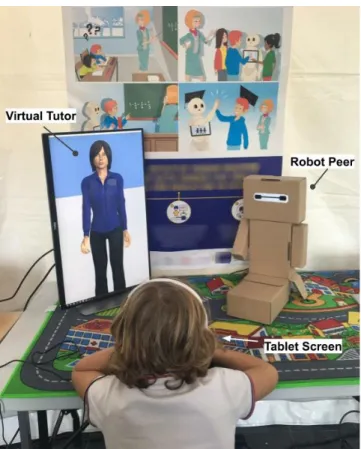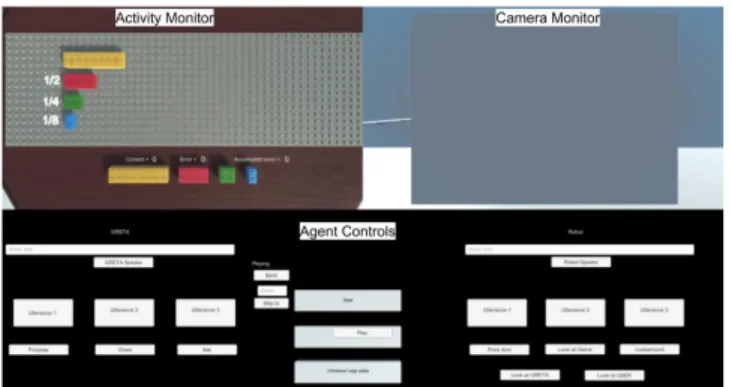HAL Id: hal-02934516
https://hal.inria.fr/hal-02934516
Submitted on 9 Sep 2020
HAL is a multi-disciplinary open access
archive for the deposit and dissemination of
sci-entific research documents, whether they are
pub-lished or not. The documents may come from
teaching and research institutions in France or
abroad, or from public or private research centers.
L’archive ouverte pluridisciplinaire HAL, est
destinée au dépôt et à la diffusion de documents
scientifiques de niveau recherche, publiés ou non,
émanant des établissements d’enseignement et de
recherche français ou étrangers, des laboratoires
publics ou privés.
Learning to be a Better Learner With a Virtual Tutor
And a Robot Peer
Sooraj Krishna, Catherine Pelachaud
To cite this version:
Sooraj Krishna, Catherine Pelachaud. Learning to be a Better Learner With a Virtual Tutor And a
Robot Peer. Workshop sur les Affects, Compagnons artificiels et Interactions, Jun 2020, Saint Pierre
d’Oléron, France. �hal-02934516�
Learning to be a Better Learner With a Virtual Tutor And a
Robot Peer
Sooraj Krishna
krishna@isir.upmc.fr ISIR, Sorbonne University
Paris, France
Catherine Pelachaud
catherine.pelachaud@upmc.fr CNRS-ISIR, Sorbonne University
Paris, France
ABSTRACT
Real-world learning interactions happening in classrooms, often involve children interacting simultaneously with teachers and peer learners. This paper presents a triadic learning interaction system which is structured to emphasize the learner on different phases of self-regulation such as planning, performance and reflection while engaging in a constructionist task of building fractions using virtual LEGO blocks with a virtual tutor and robot peer.
1
INTRODUCTION
Fractions are among the most complex mathematical concepts that children need to learn in their early years of education[6]. Sev-eral studies have reported the instructional difficulties and learner misconceptions[10] that challenge both researchers and scholars in teaching fractions. Fractions are considered as a multifaceted concept[3] that involves the following interrelated sub-constructs of part-whole, ratio, operator, quotient and measure. These sub-constructs have been identified to be relevant for various under-standings on fraction such as fraction operations (such as addition, multiplication), fraction equivalence and problem-solving. Artificial pedagogical agents are increasingly being used to provide moti-vating, engaging and personalised learning support to learners[7], especially for teaching challenging concepts in mathematical and computational thinking[2].
A review on research-based design of pedagogical agents[4] observed that agent roles with expertise such as expert or mentor have improved the learning outcomes while the motivator role had more influence over increased self-efficacy. Thus, a collaborative learning interaction involving multiple agent roles can potentially facilitate distinct regulation scaffolding. FRACTOS learning activity is thus designed around the foundational constructs of fractions and involves a virtual agent who portrays a realistic representation of a more knowledged entity capable of external regulation support such as tutor, while the robot agent, which shares the physical space with the child, acts as a peer learner facilitating co-regulation.
2
DESIGN AND IMPLEMENTATION
Regulation of learning[1] entails the processes of goal setting, moni-toring progress, analyzing feedback, adjustment of goal-directed ac-tions and/or of the definition of the goal. The proposed learning task targets children of age 7 to 11, who are in the concrete operational stage, according to Piaget’s stages of cognitive development[12]. This age group is characterized by the development and consol-idation of logical thinking as well as a decrease in egocentrism.
0This paper is a modified version of papers accepted for ACM/IEEE International
Conference on Human Robot Interaction, 2020, Cambridge, UK
Figure 1: Pilot interaction of FRACTOS task
This allows children to understand mathematical concepts and en-gage in activities that involve perspective-taking and proportional reasoning.
2.1
FRACTOS Learning Task
The FRACTOS framework is developed in Unity3D as tablet-based game which is played along with a virtual tutor and a robot peer both of which are partly controlled by a human wizard to make sure the interaction stays within the learning topic. The virtual agent and robotic agent are positioned on either sides of the ac-tivity space facing the learner at equal angles. The virtual tutor is modelled on GRETA[8], which is an Embodied Conversational Agent Platform equipped with socio-emotional and communicative behaviours such as gaze and gesture that enable designing various social attitudes for each role. The role of peer learner is played by an arduino-based humanoid robot called CardBot which was designed
and developed for the activity as a scalable and affordable alterna-tive for Wizard of Oz based HRI orchestrations. The actions of robot are animated and controlled from Unity3D by establishing a serial communication with Arduino using Uduino Unity plugin[11]. The speech of the robot is generated using the IBM Watson service and is modified later in Unity to sound like a child as it suits the role of a peer learner better. The system enables collecting the regulation behaviours of the child from the gaze behaviours and performance trace measures from the tablet such as error rate, response time, time for task completion, during the activity and enables the wizard to trigger appropriate agent behaviours to promote regulation.
2.2
CardBot : The robot peer
A great deal of Wizard of Oz interactions in HRI often involves the use of robots that are sophisticated and expensive, yet restricted to their minimal verbal and non-verbal behaviours and perceptual abilities for making the wizard manipulation feasible[9]. The field of HRI, being inherently multidisciplinary and dynamic, thus calls for robust, affordable and scalable solutions for rapid prototyping of human robot interactions involving minimal engineering efforts. CardBot is designed to serve this purpose and aims to evolve as a platform for rapid prototyping in HRI.
Cardbot consists of an Arduino responsible for actuation of head and arm movements, which can be composed and controlled by the wizard through a serial communication established between Arduino and Unity3D[11]. This equips the robot to display basic non-verbal behaviours such as eye gaze, head movements and arm pointing gestures. The speech based interaction is powered by IBM Watson that enables speech synthesis and analysis. An android app running on the smartphone mounted on the head module of the CardBot displays animated virtual eyes and performs eye gaze to add expressions for the robot.
Figure 2: Wizard console for FRACTOS task
2.3
Game instance
The FRACTOS game consists of the tasks for building new frac-tions using the fundamental blocks of 1/2, 1/4 and 1/8. For instance, to build the fraction of 5/8, the child can chose to put together 5 blocks of 1/8. The virtual tutor agent facilitates external regulation through instructional behaviours while the robot peer is charac-terized by think aloud behaviours to promote co-regulation. The interaction starts with an introduction phase where both agents
introduce themselves to the child by engaging in a small talk. Then starts the activity phase of 15 minutes involving 5 exercises of building fractions. Each fraction building task involves both agents exhibiting regulation behaviours during the three phases [13] of learning regulation as follows:
• Planning Phase: Verbalization or behaviour related to the selection of procedures necessary for performing the task which is done before starting to build the fraction. Tutor agent : You can use the red blocks to build this fraction. Peer agent: Which block shall we use for building 5/2 ? Red or green?
• Performance Phase: Verbalization or behaviour related to the ongoing on-task assessment and the degree to which performance is progressing towards a desired goal. Tutor agent : Try using the 1/2 blocks instead.
Peer agent: Do you think 1/2 block is right one, my friend ? • Reflection Phase: Verbalization or behaviour related to
re-viewing task performance and evaluating the quality of per-formance which is done after building the required fraction. Tutor agent : Now tell me, how many red blocks did you use for building this fraction?
Peer agent: I think we took three 1/2 blocks to build 3/2. Am i correct, my friend ?
The FRACTOS game enables the wizard operator to advance through the interaction step by step and also return back to any specific instance in the interaction script if needed, for example when the learner is distracted from the activity (see Figure 2). The wizard interface is split into 3 parts:
• Activity monitor: Real-time monitoring of the tactile inter-actions which the child is performing on the tablet screen. This section also indicates error notification, accumulated error count and the current score of the learner in the task. • Camera monitor: Real-time video feed from the camera fac-ing the learner, along with the information on the gaze di-rection of the learner.
• Agent Controls: Includes triggers for pre-scripted or custom text inputs instantiated to multimodal behaviours for both agents, which can be triggered whenever needed by the wizard.
3
DISCUSSION AND FUTURE WORK
The FRACTOS learning task was showcased to public for a pilot interaction with 25 children between age 5 to 13 at a science festival (see Figure 1), which gathered positive feedback on agent perception and task engagement from children through questionnaires and also receiving appreciation from parents and teachers alike. The proposed research plans to conduct studies using the FRACTOS task in primary schools to explore the two key aspects of regulation scaffolding[5] which are the mode and the moment for regulation scaffolding.
4
ACKNOWLEDGEMENTS
This project has received funding from the European Union’s Hori-zon 2020 research and innovation programme under grant Agree-ment Number 765955.
REFERENCES
[1] Linda Allal. 2010. Assessment and the regulation of learning. International encyclopedia of education 3 (2010), 348–352.
[2] Matthew Berland and Uri Wilensky. 2015. Comparing virtual and physical robot-ics environments for supporting complex systems and computational thinking. Journal of Science Education and Technology 24, 5 (2015), 628–647.
[3] Charalambos Y Charalambous and Demetra Pitta-Pantazi. 2007. Drawing on a theoretical model to study students’ understandings of fractions.Educational studies in mathematics 64, 3 (2007), 293.
[4] Yanghee Kim and Amy L Baylor. 2016. based design of pedagogical agent roles: A review, progress, and recommendations. International Journal of Artificial Intelligence in Education 26, 1 (2016), 160–169.
[5] Sooraj Krishna, Catherine Pelachaud, and Arvid Kappas. 2019. Towards an Adaptive Regulation Scaffolding through Role-based Strategies. InProceedings of the 19th ACM International Conference on Intelligent Virtual Agents. ACM, 264–267.
[6] Susan J Lamon. 2012.Teaching fractions and ratios for understanding: Essential content knowledge and instructional strategies for teachers. Routledge.
[7] Maja Matarić. 2014. Socially assistive robotics: human-robot interaction methods for creating robots that care. InProceedings of the 2014 ACM/IEEE international conference on Human-robot interaction. ACM, 333–333.
[8] Catherine Pelachaud. 2015. Greta: an interactive expressive embodied conversa-tional agent. InProceedings of the 2015 International Conference on Autonomous Agents and Multiagent Systems. International Foundation for Autonomous Agents and Multiagent Systems, 5–5.
[9] Laurel D Riek. 2012. Wizard of oz studies in hri: a systematic review and new reporting guidelines.Journal of Human-Robot Interaction 1, 1 (2012), 119–136. [10] HRH Sarwadi and Masitah Shahrill. 2014. Understanding students’ mathematical
errors and misconceptions: The case of year 11 repeating students.Mathematics Education Trends and Research 2014, 2014 (2014), 1–10.
[11] Marc Teyssier. 2018. Uduino. https://marcteyssier.com/uduino/.
[12] Barry J Wadsworth. 1996.Piaget’s theory of cognitive and affective development: Foundations of constructivism. Longman Publishing.
[13] David Whitebread, Sue Bingham, Valeska Grau, Deborah Pino Pasternak, and Claire Sangster. 2007. Development of metacognition and self-regulated learning in young children: Role of collaborative and peer-assisted learning.Journal of Cognitive Education and Psychology 6, 3 (2007), 433–455.

